Fine Dining Course in Singapore
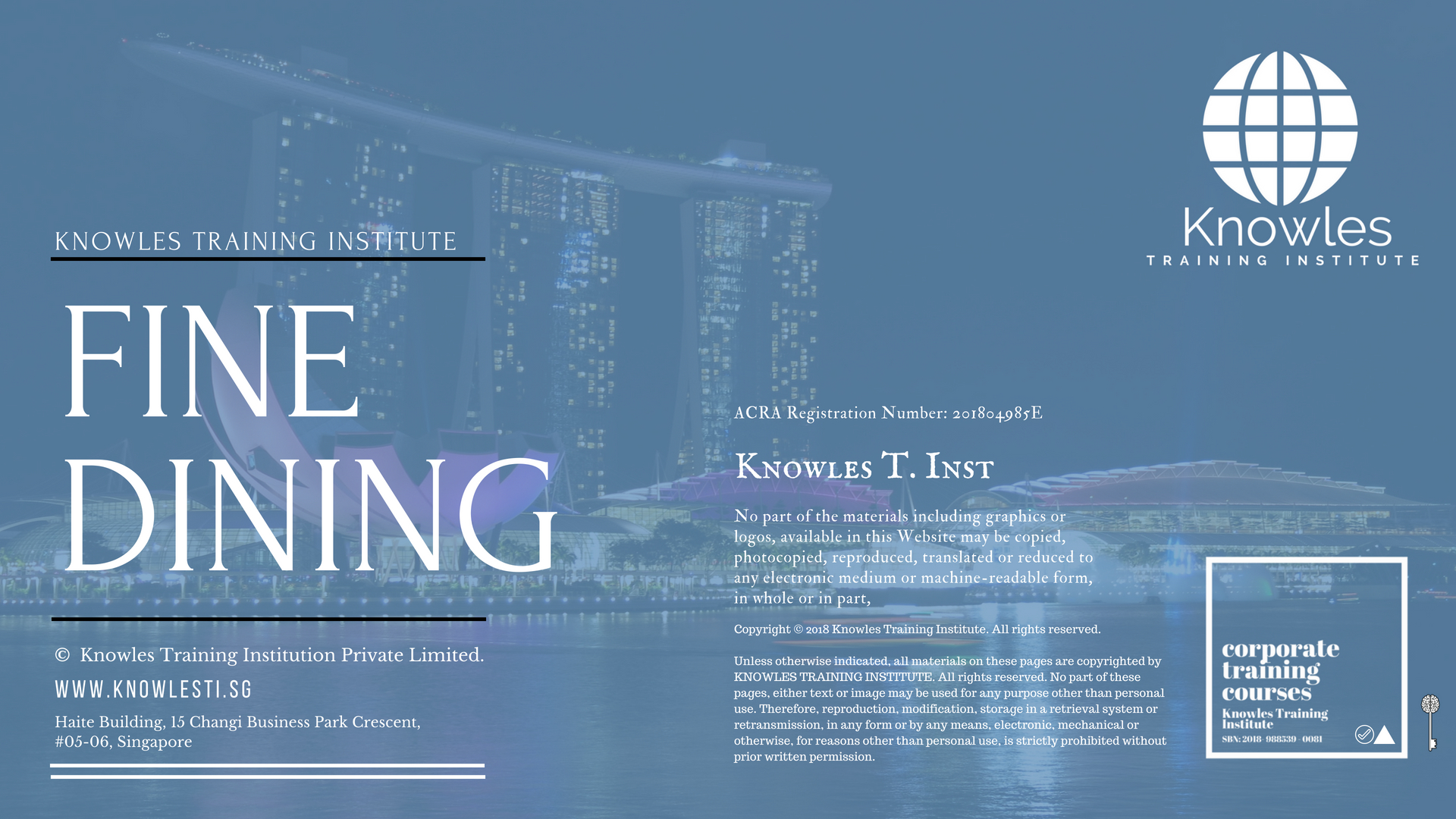
About This Fine Dining Training Course
Fine Dining Course in Singapore
Basic social etiquette is the most important part of nonverbal communication Fine dining is one of the style of dining which usually takes place at fancy expensive restaurants and shows a person’s manners. Fine dining is not just the expensive dining only rather it is a whole new dining experience. Fine dining is not about just eating food. It’s a culinary experience steeped in tradition, and there is a lot of etiquette involved.
Fine dining is like passing an exam of etiquette. It’s all about your food manners. You can be judged soon if you attempt a mistake and all this culinary experience can turn into a nightmare. So, if you are looking to avoid such mistakes then this is the right course for you.
In this course you will learn all the etiquettes of fine dining and that why fine dining is totally different from casual dining. This course will guide you to use the right utensil at the table. This course will help you if you are unfamiliar with the ins and outs of dining at finer food restaurants and establishments. This course is the quick refresher to keep you up to par. We will provide you with the whole knowledge from the attire, the table, the napkin, the menu till to the bill.
After this course, you will gain excellence in fine dining as a host. Guest or a great manager. Join us and learn the rules.
Who Should Attend This Fine Dining Workshop
This Fine Dining workshop is ideal for anyone who would like to gain a strong grasp and improve their Fine Dining.
All Staff Within An Organisation
Managers
Team Leaders
Executives
Assistants
Officers
Secretaries
Group Size For This Fine Dining Training Program
The ideal group size for this Fine Dining course is:
Minimum: 5 Participants
Maximum: 15 Participants
Course Duration For This Fine Dining Skills Course
The duration of this Fine Dining workshop is 2 full days. Knowles Training Institute will also be able to contextualised this workshop according to different durations; 3 full days, 1 day, half day, 90 minutes and 60 minutes.
2 Full Days
9 a.m to 5 p.m
Fine Dining Course Benefits
Below is the list of course benefits of our Fine Dining course
- Learn advanced skills and thoughtful planning.
- Influenced others with your manners.
- Encourage you to adopt etiquettes.
- Help one to reflect higher social class
- Fine dining skills will impact individual manners and behaviour generally in day to day life
- Helps to lead a more organized life
- It will help to create a strong influential personality
- Encourage individuals to obtain career objectives.
Fine Dining Course Objectives
Below is the list of course objectives of our Fine Dining course
- Learn the dining etiquettes.
- Know the difference between American and continental dining styles.
- Enable you to choose the correct eating utensil and use it properly.
- Helps you spot difference among formal seating for social dining vs formal seating for
- business dining.
- Identify world-class table manners.
- Motivate you to dine at any fancy restaurant without any fear of mistakes.
- Assist you to learn to eat a variety of tricky foods.
- Develop confidence as a host, guest or the guest of honour.
- Perceive the place setting to determine what comes next and what to expect.
- Helps you in your professional careers and build opportunities.
- Enable you to organize fine dining at your place.
- Provide you with all the possible skills to enjoy fine dining.
- Learn the art of arrangements.
Course Content For This Fine Dining Training Course
Below is the list of course content of our Fine Dining training course
- What qualifies as fine dining?
- Does fine dining matters?
- What are table manners?
- Why dining etiquettes matters?
- How do you know about fine dining?
- What is the fine dining etiquettes?
- What is the difference between fine dining and casual dining?
- Describes the benefits of fine dining skill?
- Explain the importance of fine dining?
- How fine dining skills helped in maintaining influence on others?
- How fine dining impact meetings?
Fine Dining Value Added Materials
Each participant will receive the following materials for the Fine Dining course
Fine Dining Learner’s Guide
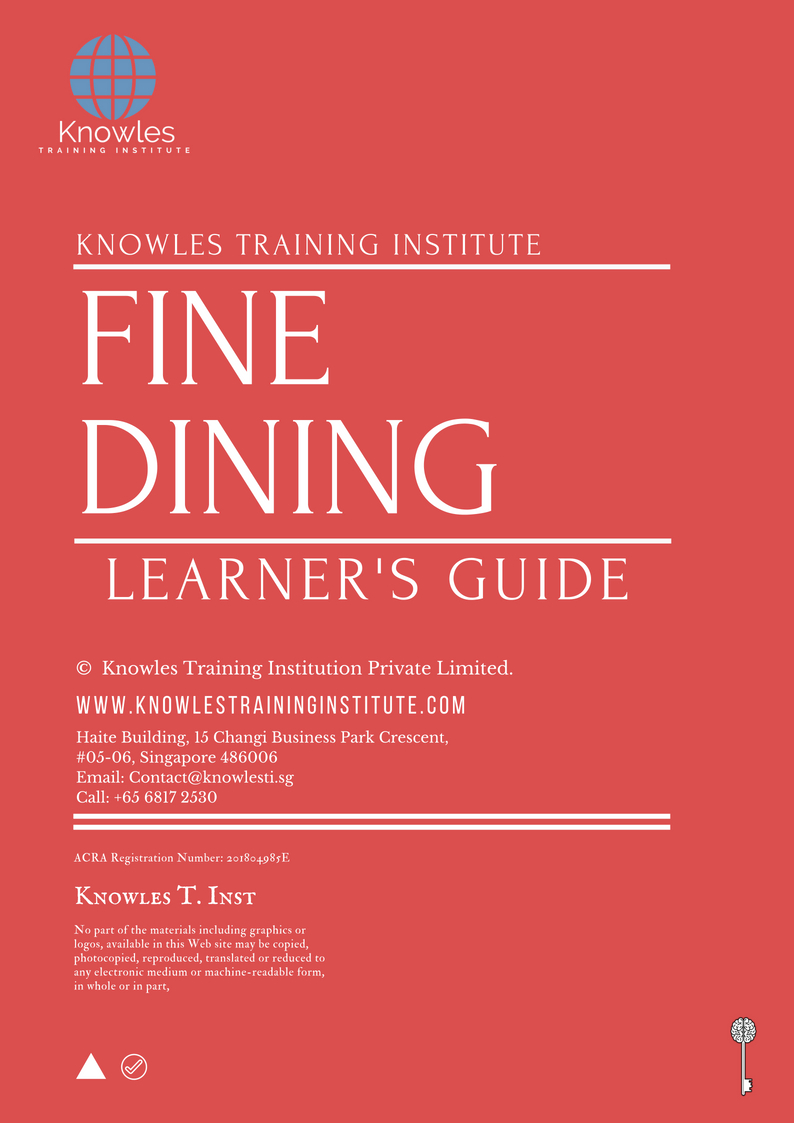
Fine Dining Key Takeaways Notes
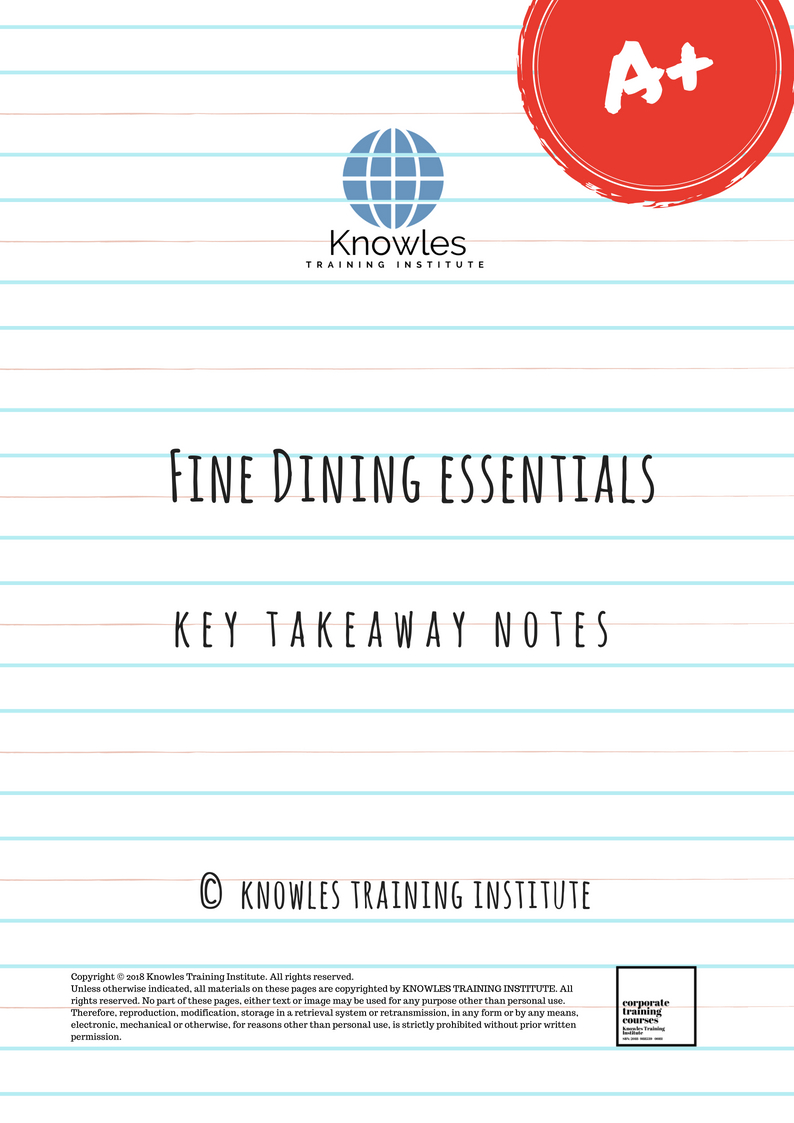
Fine Dining Essentials Ebook
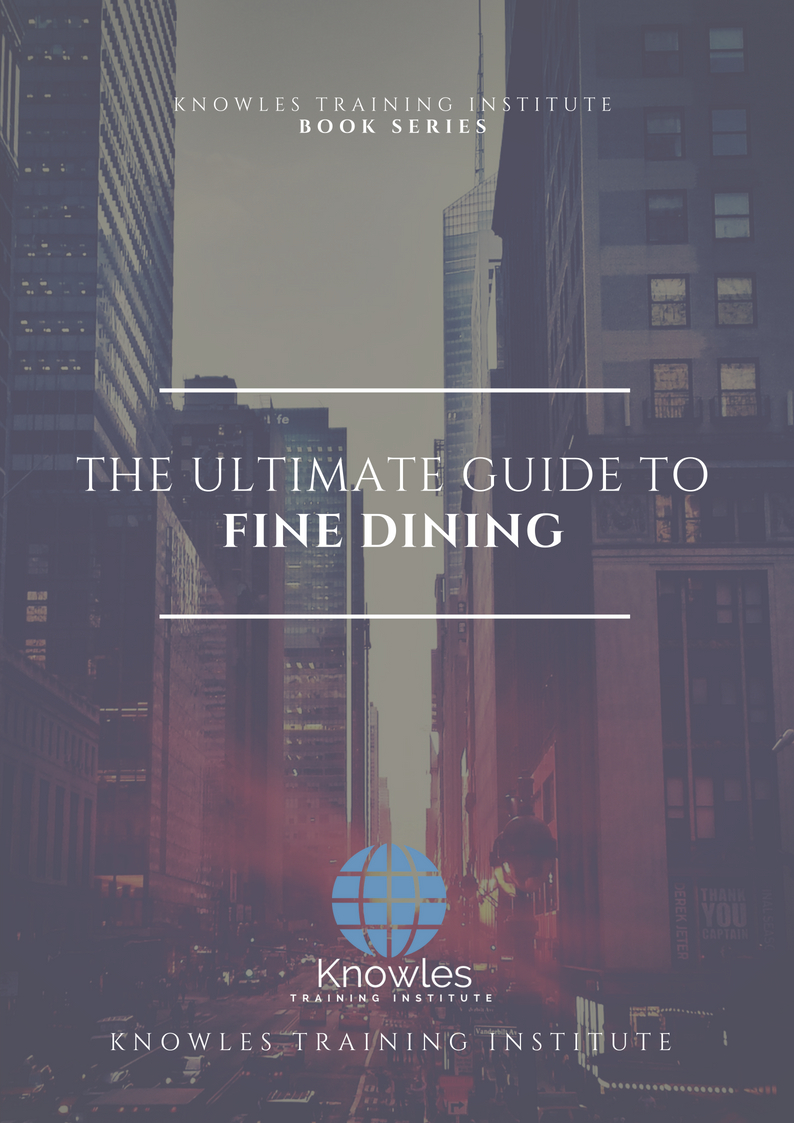
Fine Dining Course Handouts
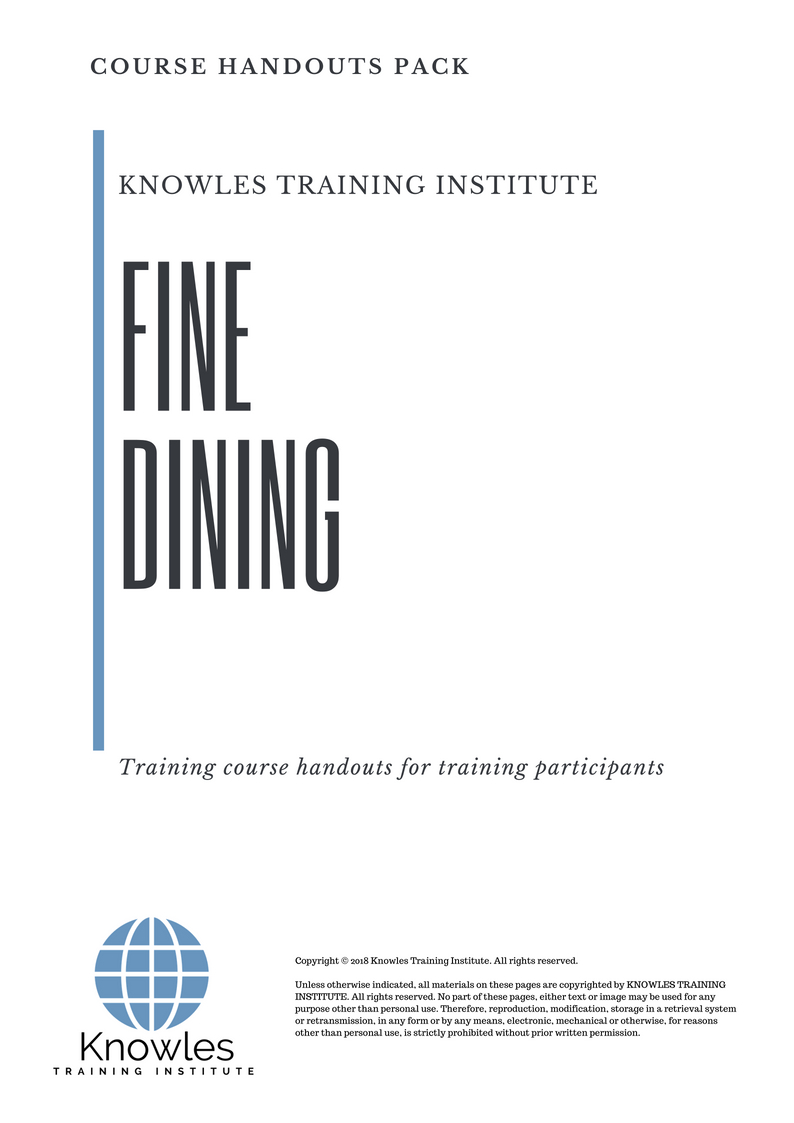
Fine Dining 30-Day Action Plan
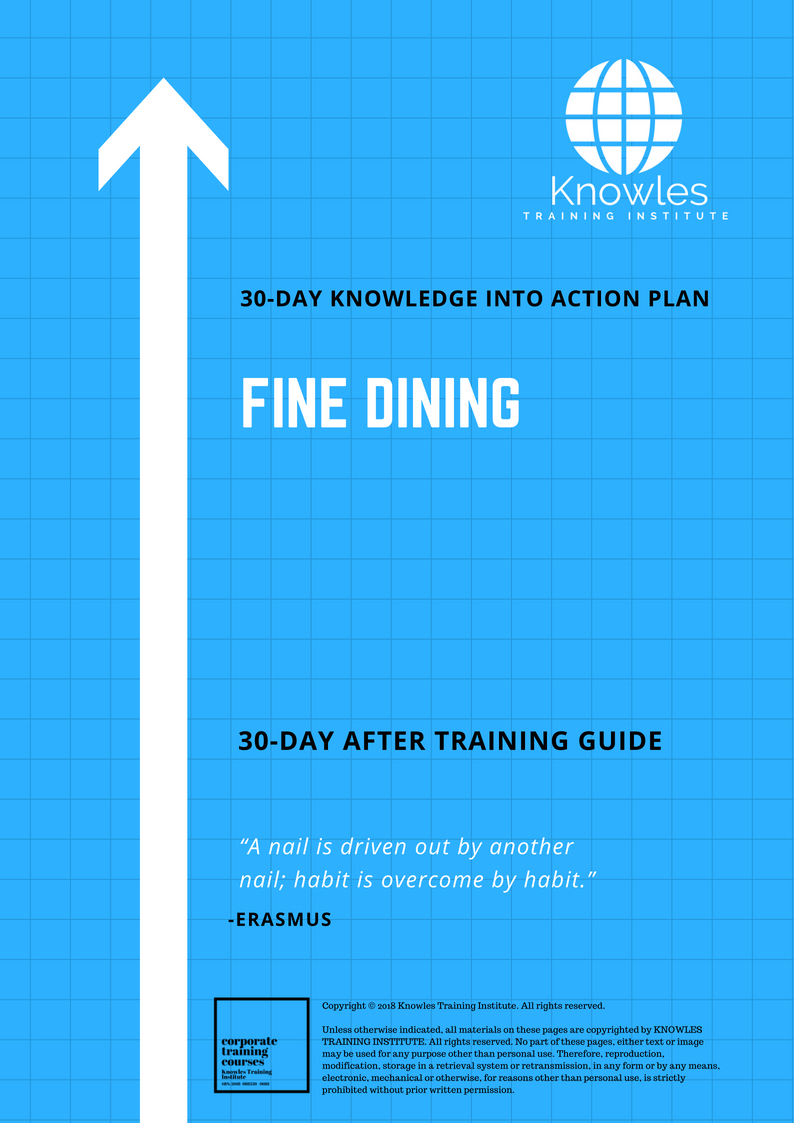
Fine Dining MindMaps Pack
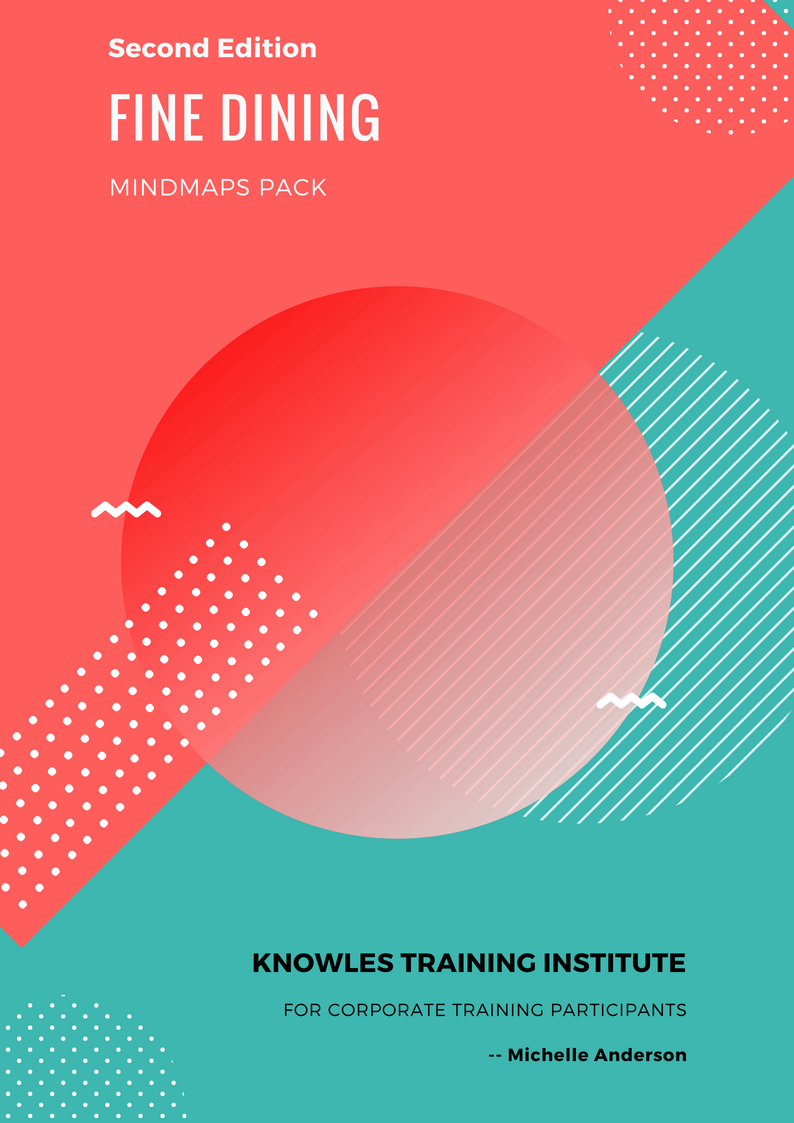
Fine Dining PPT Slides Used During Course
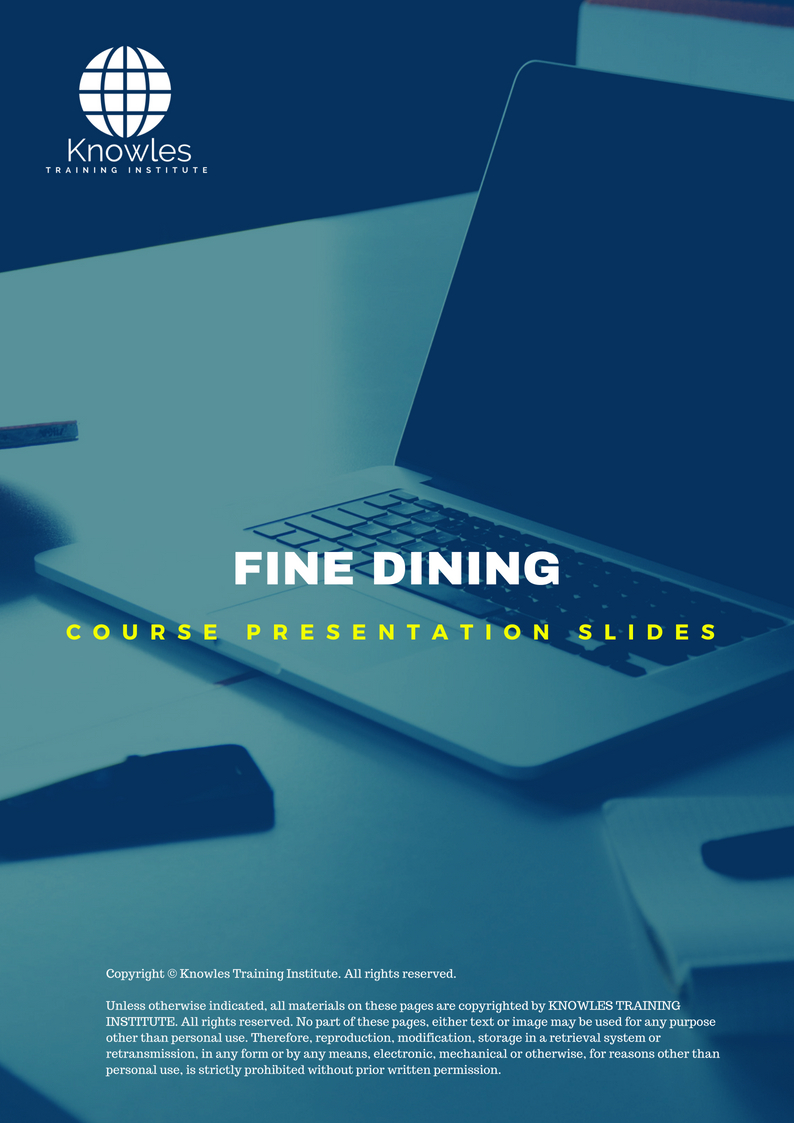
Fine Dining Long-Term Memory Flashcards Pack
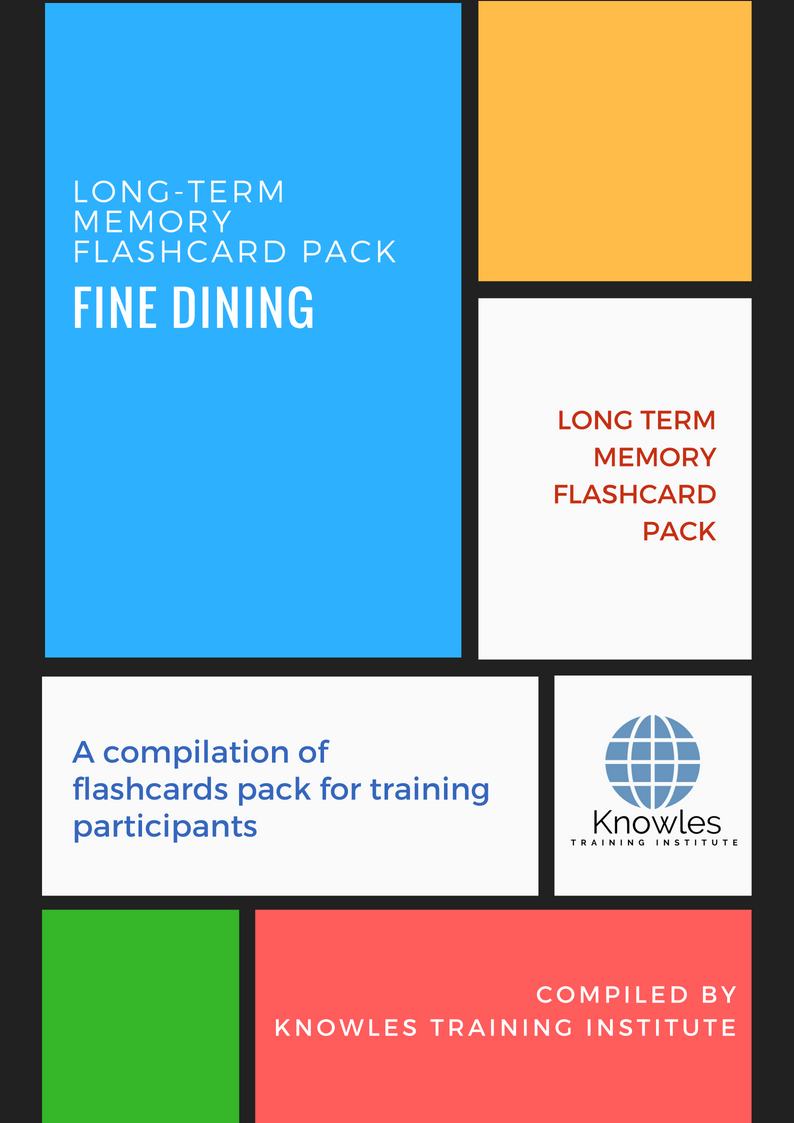
Fine Dining E-Learning Course
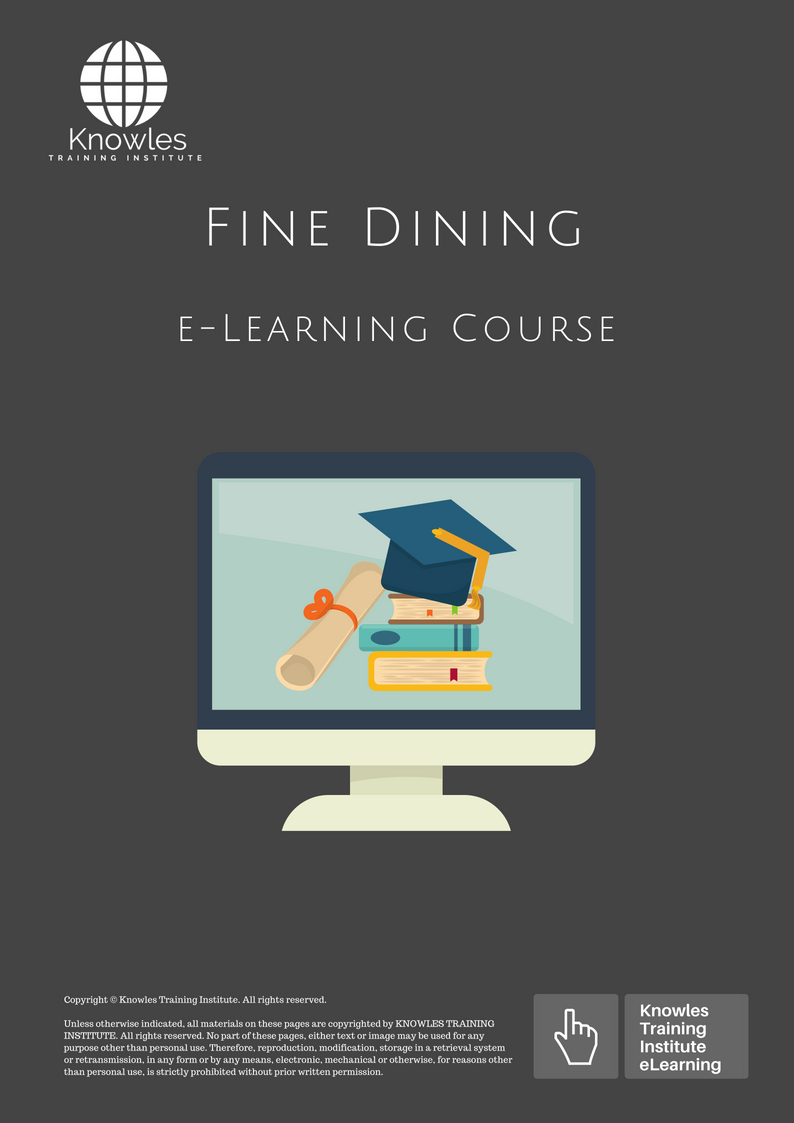
Fine Dining Online Video Course
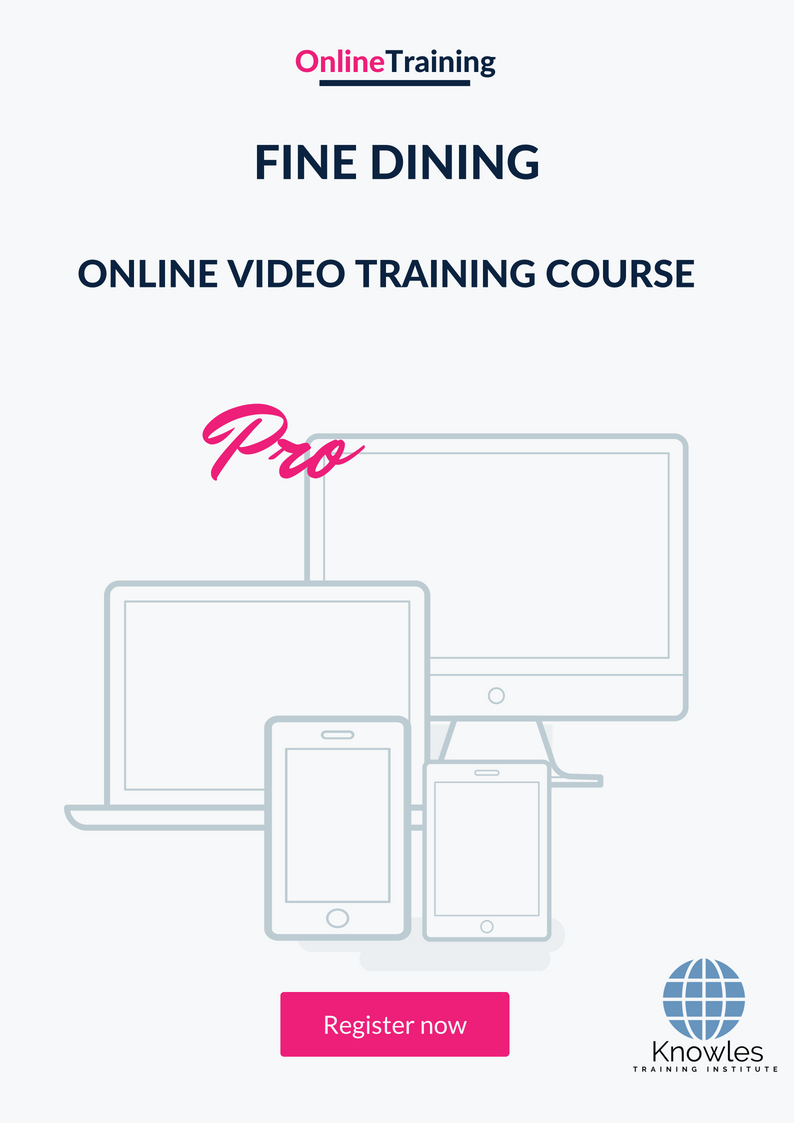
Fine Dining Essentials Audiobook
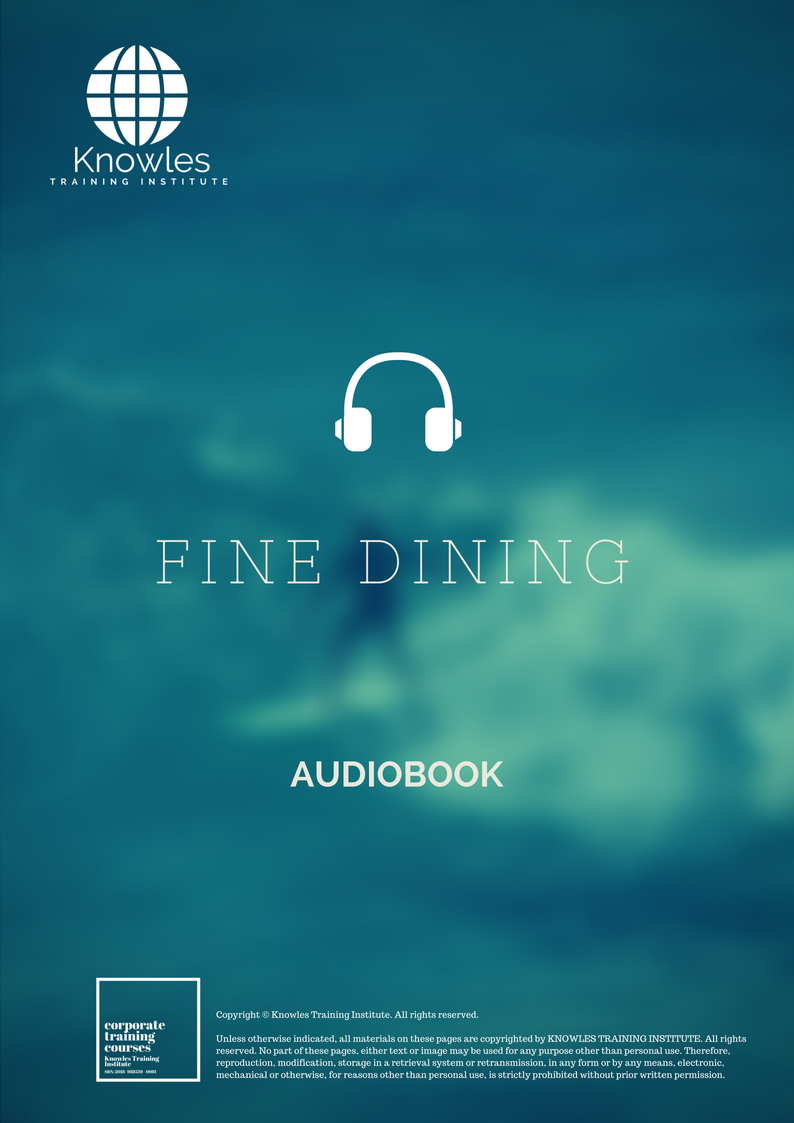
Fine Dining Infographics Pack
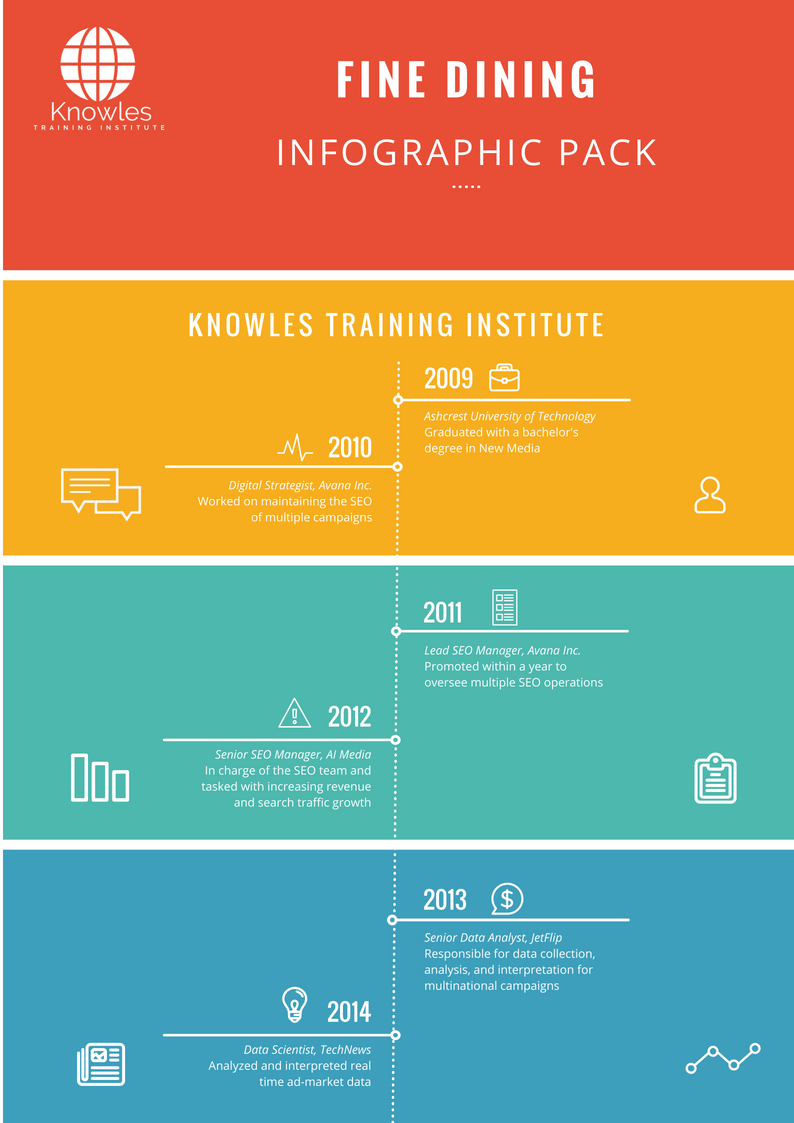
Fine Dining Certification
Each course participant will receive a certification of training completion
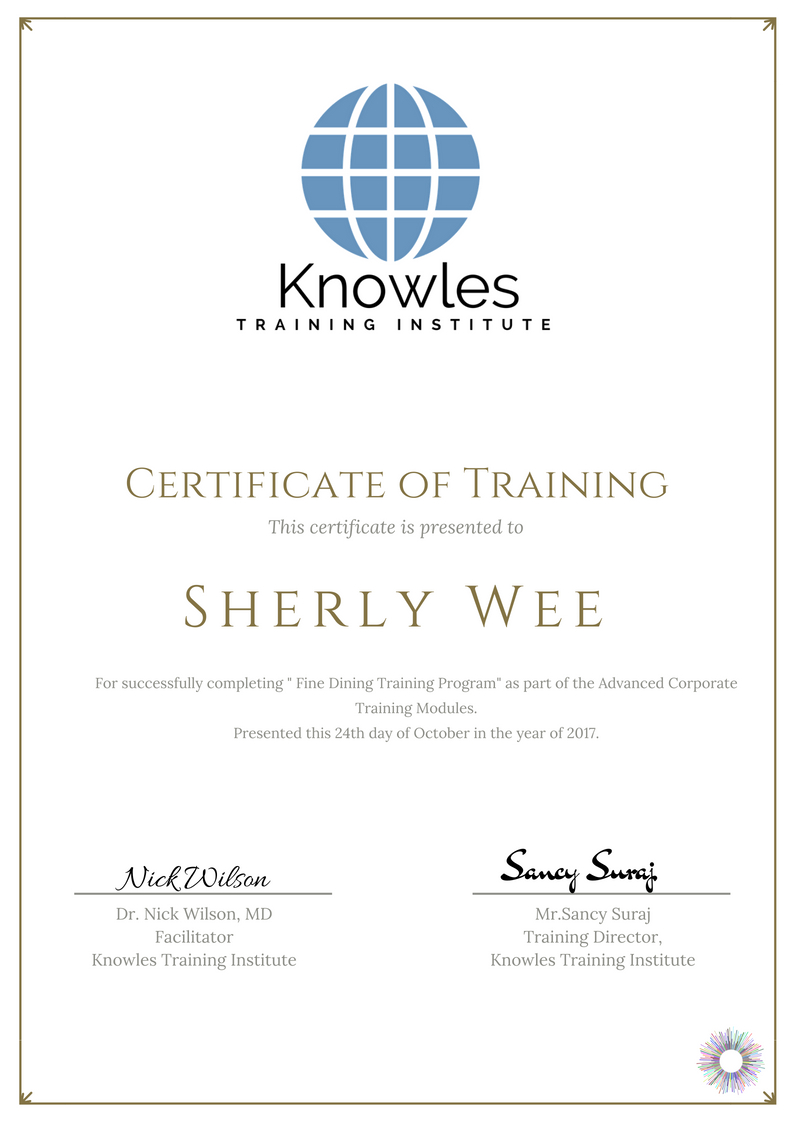
Course Fees
There are 4 pricing options available for this Fine Dining training course. Course participants not in Singapore may choose to sign up for our online Fine Dining training course.
SGD 889.97 For a 60-minute Lunch Talk Session.
SGD 389.97 For Half Day Course Per Participant.
SGD 589.97 For 1 Day Course Per Participant.
SGD 789.97 For2 Day Course Per Participant.
Discounts available for more than 2 participants.
Course Facilitator
Our Trainers are Subject Matter Experts.
Our subject matter experts stimulate discussions, generates ideas, foster curiosity and excitement among all of our training participants. All of our trainers have a minimum of 10-20 years in the training industry.
Upcoming Fine Dining Training Course Schedule
Contact us for the latest Fine Dining course schedules:
Phone: +65 6714 6663
Email: contact@knowlesti.com
Message:
Download Fine Dining Course Brochure
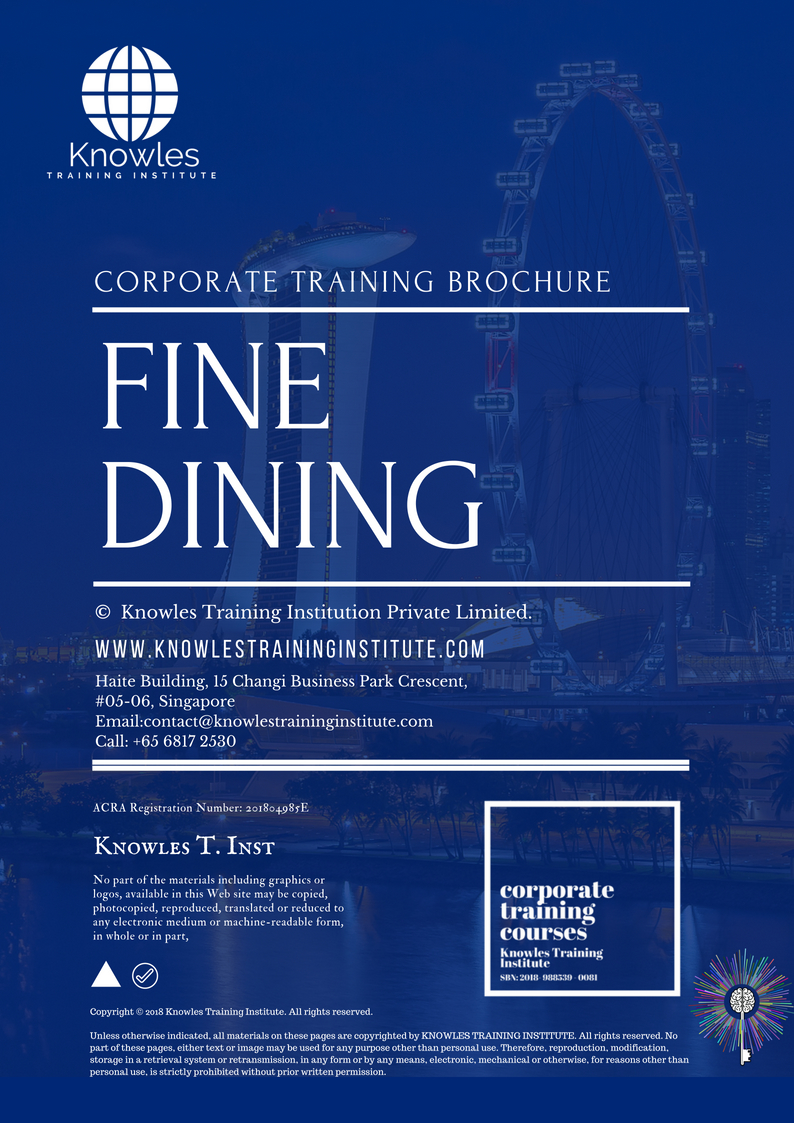
Request for this Fine Dining course brochure. Fill up the short information below and we will send it to you right away!
Post-Training Support: A vast majority of training does not have any effect beyond 120 days. But to work, training has to have a strong pre- and post-training component. Post-training reinforcement consequently helps individuals to recall the understanding and ask questions.
Blended Learning: Learning does not occur in the classroom. Virtually everybody prefers distinct ways of learning. Successful learning should have a multi-channel, multi-modal strategy.
We Understand The Industry: Similarly, we’ve got a profound comprehension of the business, business design, challenges, strategy and the that our participants are in and have designed the courseware to cater to their professional needs.
Course Content: Knowles Training Institute’s material is relevant, of high quality and provide specific learning outputs. As a result, Participants will leave the training course feeling as they have gained a strong understanding and will also be in a position to execute what they have learned sensibly.
Course Development — The workshop modules follow a systematic and logical arrangement. Therefore, this structure helps to ensure that the course material allows the facilitators to deliver the course in a logical arrangement. Consider the subjects as building bricks into learning, our facilitators slowly build towards a comprehensive picture of this entire topic.

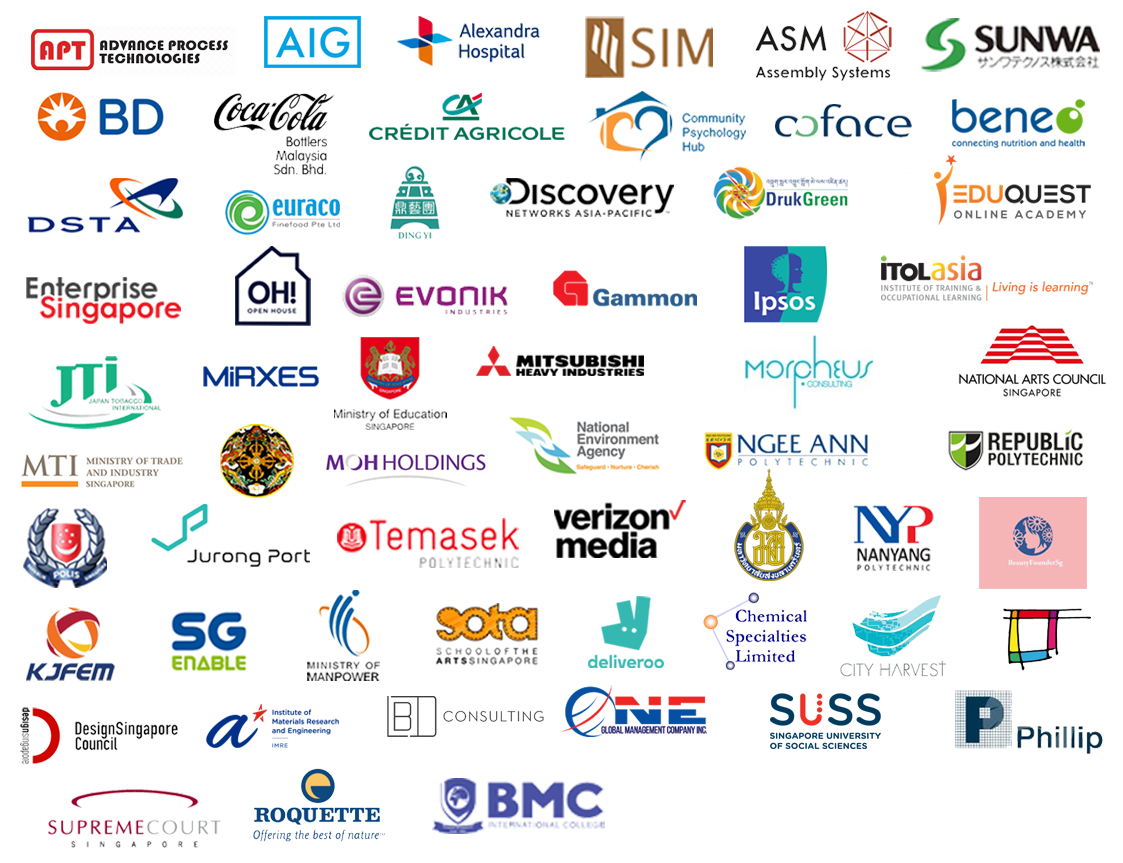
Course Enquiries

Fill up the form and we will get back to you in less than 1 working day.
Alternatively, give us a call to have one of our training consultants contact you. Our corporate training courses can be contextualized to meet your organization’s training needs. Leverage on our large pool of professional trainers and consultants for your organization’s training needs.
Office Address: 60 Paya Lebar Rd, #07-54 Paya Lebar Square, Singapore 409051
Office Phone: +65 6714 6663
Email: contact@knowlesti.sg
We Guarantee 100% Privacy. We Respect Your Privacy. Your Information Will Never Be Shared.
Questions
Consider the American style, which is to hold the knife in the right hand, and the fork in the left hand holding food. After cutting the food, place the knife on the edge of the plate. Eat food by altering fork position to the master hand (usually the right hand). Be careful as the left hand, arm or elbow on the table is a lousy dining etiquette.
Dining Etiquette. Proper etiquette is essential for keeping a professional image at lunch or dinner interviews, including social business circumstances. Although the best guide is common sense, it is best to find online the best ways that professionals dine correctly.
Here are several dining etiquette rules every professional should know
- Never draw out someone’s chair for them
- Follow the guest’s eating pace
- Never ask for a to-go box
- Remember to break bread with hands
- Avoid using the cell phone during the meal
- Do not use the napkin as a tissue
Here are several dining etiquette rules every professional should know
- Never draw out someone’s chair for them
- Follow the guest’s eating pace
- Never ask for a to-go box
- Remember to break bread with hands
- Avoid using the cell phone during the meal
- Do not use the napkin as a tissue
Most etiquette consultants agree that the napkin should be put on the chair when leaving the table for a moment during the meal. Place the napkin on the left of the plate, slightly folded up to hide any stains, after the meal.
Putting elbows on the table appears guarded. This behaviour often places both elbows on the table while pushing meat into your mouth while glancing around the table. Hence the reason why putting elbows on the table is not a good idea, and hence why this behaviour became considered rude at a polite dining table.
Here are several essential dining etiquette rules to adhere to:
- Turn off or put to silent the cell phone.
- Never talk with a full mouth
- Taste your food before giving salt or pepper.
- Avoid cutting all the food before eating; it looks weird.
- Refrain from blowing on the food.
The American style is to place the fork and knife together and parallel at the 11 o’clock position with the fork tines still up, to signal that you have finished your meal. The Continental or European style places the fork tines down instead of up.
The etiquette rules of today serve essential functions such as:
- Prevention of insensitive remarks
- Elevates perception of status
- Making a good first image
- Etiquette gives personal security – Behave appropriately in a given situation to be comfortable.
- Clearer communication
- Protection from hurting feelings
Excellent dining etiquette is for a formal setting. These rules do not apply during casual meetings or social gatherings. Waiters serve food to allocated seats specific for every individual. Also, fine dining etiquette and table manners are synonymous in meaning.
Teach the following rules that apply during the meal:
- Pause for the host to begin to eat.
- Offer to the person on the left and pass everything to the right.
- Used silverware should never be on the table; instead, they should rest on the plate.
- Place the napkin on the chair when leaving the table during a meal.
- Pass the salt and pepper together.
Table manners are the practices of eating, which includes the use of utensils. Diverse cultures observe different rules for table manners. Each family or group sets its guidelines for how strictly to follow these rules.
When a formal affair has no guest of honour, serve the most prominent female guest first. There are various ways to serve a formal meal, of course, depending on individual circumstances. Generally, the ladies are served first.
The basic rules of etiquette are cultivated speech, basic courtesy, neat appearance, and self-control over emotions. Every self-respecting person should know these basic rules. For instance, when doing the invitation to eat, prepare to pay for the meal.
There is no need to open a large napkin fully; fold it in half. The host signals the end of the meal by putting his napkin on the table. In turn, the guests should follow suit by placing their napkin neatly on the table to the left of the plate without showing the dirty part of the napkin.
When it comes to eating etiquette, there are a few general rules to remember: refrain from “drinking” the soup, and do not blow on hot food. The fork should not be used to pick up food, only to spear it. Finally, do not use cutlery to gesture to other dining guests. Refrain from putting the entire cutlery in the month.
Here are some key pointers to take note when dining:
- Avoid chewing food with your mouth open. People often make this mistake without being aware of it.
- Do not eat the food in a hurry.
- Refrain from speaking with a full mouth.
- Excessive reaching for other food. Kindly ask someone else to get it for you.
- Do not stuff the mouth with too much food.
- Do not blow on the food.
- Finally, do not needlessly wave utensils unnecessarily.


